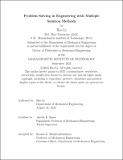Problem Solving in Engineering with Multiple Solution Methods
Author(s)
Li, Hao
DownloadThesis PDF (2.847Mb)
Advisor
Hosoi, Anette E.
Terms of use
Metadata
Show full item recordAbstract
One of the key challenges of Engineering Education is developing students’ ability to navigate and solve problems that have multiple solution paths. In order to accomplish this, the process of solving these moderately- and ill-structured problems needs to be better understood. We used two approaches to achieve this.
First, we performed problem solving experiments with students (two preliminary studies and a main study). One preliminary study found that expert problem solvers tended to start solving problems with simpler methods compared to novices. The other preliminary study found that students using reasoning and intuition had better outcomes than students who "dived in" to detailed analysis. The main experiment was conducted to illustrate the possibilities of student problem solving activity in a more open-ended way. Here, the subject population consisted of 72 undergraduate and graduate students recruited from the author's institution. The participants were given a problem with a well-defined goal but no well-defined method. After attempting to solve the problem, the participant was given a short questionnaire. The results were coded to extract the method used and the approximate time used for each method. Student performance was compared against school year, the choice of method, and the number of methods used. No significant differences in performance were found between students in different years. However, it was found that students who either 1) used simpler methods (methods with lower solve time) or 2) used more than one method tended to perform better than average, though the results are not statistically significant. Additionally, survey results were analyzed to understand the reasons for students' method choices.
Second, we built a mathematical model to describe the behavior of a problem solver with multiple methods at their disposal. Each solution method was modeled with a fixed solve time, and the problem solver may switch between methods. We start with a basic model with two solution methods, and additional complexities are successively added. Next, we present two versions of the model: using Markov and Poisson processes to describe the method transition behavior. Two optimization problems are presented: one whose objective is to maximize the solve probability given a time limit, and one whose objective is to minimize the average solve time to achieve problem solving success. We give analytic solutions for the solve probability and average solve time for the case with two methods. We also present conditions for which switching methods is beneficial. It was found that whenever there existed sufficiently short methods for solving a problem, using multiple methods (i.e. switching methods) can improve the problem solving outcome. The model and experiment are then matched, and the results are used to develop a framework of strategies for teaching students to solve problems with multiple solution methods.
Date issued
2023-09Department
Massachusetts Institute of Technology. Department of Mechanical EngineeringPublisher
Massachusetts Institute of Technology